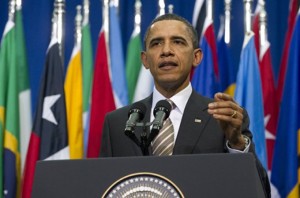By Trent Boultinghouse
Council on Hemispheric Affairs
As President Barack Obama made the case for reelection last week at the Democratic National Convention, he launched himself as a calculated defender of Washington’s foreign policy interests who has grudgingly won international respect.

To reinforce this image, the Obama campaign has turned to a series of well-publicized United States foreign policy successes carried out during his first term, such as the president’s authorization of a successful raid on Osama bin Laden’s compound in Pakistan and his decision to withdraw American troops from Iraq. Yet, at the convention, aside from appearances from various Hispanic political candidates, there was little mention of a long-term plan for Central and South America.
This is a glaring lapse in the president’s oft-touted foreign policy record that soon will beckon to be addressed as a leftist current threatens to usurp the United States from its fast dealing historical position of dominance in hemispheric affairs.
Latin American Expectations for an Obama Presidency
Most of the hemisphere looked to the Obama 2008 campaign as a pledge of fundamental change in the United States’ approach towards the region, although specifics were vague and primarily concerned Cuba.
Upon taking office in 2009, 62% of the region looked to the U.S. president with enthusiasm and approval. This figure in itself was notable, because it marked a departure from Latin America’s tradition of being on the receiving end of American interventionism, historically promulgated under a blanket of rhetorical jingoism.
One of the ways Obama was able to foster the possibility for change in U.S.-Latin American relations was his promise to craft a non-interventionist strategy toward a region where anti-Americanism has found several convenient pockets from which to blossom.
Indeed, the chronicle of Obama’s political rise occurred in the post-9/11 decade, entering office in January 2009 cognizant of the well-publicized foreign embarrassments that plagued the Bush years, including the infamous “Mission Accomplished” declaration in Iraq. At the time, the hope throughout the continent was that Obama would bring change not only to domestic policies, but to Washington’s foreign policy objectives.
However, the inconsistency in which Obama has addressed the region has reinforced the idea that the U.S. leader lacks even the basic levels of a formal Latin American strategy. This, in turn, has portrayed him as avoiding even distant prospects to more robust relations with the U.S.’ hemispheric neighbors.
In fact, Washington’s tentative, hesitant response to the illegitimate Honduran coup d’état in 2009 reinforced the idea to many that the same pragmatism and practicality that transformed candidate Obama into the American head of state also prevented him from successfully conceptualizing a comprehensive strategy for the entire continent.
In trying to shun the imperialistic rhetoric of previous administrations, the non-interventionism that the Obama administration has applied to the region has been translated into indifference for the less fortunate citizens of the continent.
To be fair to the White House, this is an over-simplified critique that ignores how the president was hamstrung during his first term between balancing an ambitious domestic agenda with a spiraling fiscal crisis both at home and on European shores.
Faced with the task of managing two large-scale military operations in Iraq and Afghanistan, Obama’s foreign policy team inevitably has been stuck in the Middle East.
Some critics of Obama’s foreign strategy, including Colombian president Juan Manuel Santos, have argued that Washington’s Middle Eastern interests have been misguided, ignoring the trove of symbiotic potential scattered throughout the countries of the Western hemisphere. Of particular note, Santos proclaimed earlier this year that, “If the United States realizes its long-term strategic interests are not in Afghanistan or Pakistan, but in Latin America…there will be great results.”
Obama’s Latin American Accomplishments
While not extensive by any means, the Obama White House can boast a small number of accomplishments in Latin America. In one of the rare examples of bipartisanship in the 112th Congress, Obama signed into law Free Trade Agreements with Panamá and Colombia in late 2011. While they have their critics, the agreements were originally negotiated under Obama’s predecessor, George W. Bush, confirming that Washington still had allies at the tip of the continent at a time when Ecuador and Venezuela, for example, have scornfully criticized American influence.
Outside of trade initiatives, there are few other issues that the White House has been able to effectively target. The U.S. embargo on Cuba, a perennial topic of debate in regional forums, has not advanced toward any resolution.
While it is true that Obama has eased some travel restrictions to the island, for example, his refusal to reevaluate the nation’s economic embargo all but ensures that Washington’s Cuban policy will remain a lighting rod of criticism from many hemispheric governments that view American policy as outdated.
As a result, many analysts insist that the White House reevaluate its position on Havana, which will be even more difficult to ascertain following its failure to close the Guantánamo Bay prison camp in the first Obama term.
Obama’s trips to regional neighbors have struggled to amount to little more than showmanship. At the Cartagena summit, for example, Secret Service members’ hiring of prostitutes overshadowed the president’s appearance. Moreover, a short five-day trip to Brazil, El Salvador, and Chile in 2011 produced little in the way of substantive results.
Some four years later, as Latin America remains miffed at the lack of an upgraded and modernized “Good Neighbor Policy,” numerous left-of-center governments scattered throughout Central and South America have rejected the Washington-praised neoliberal economic model of unobstructed hemispherical trade as they join the rest of the hemisphere in seeking other trading partners in Asia, a disconcerting development for the United States.
Moreover, this wave has channeled a populist fervor that aims to funnel uneven distribution of wealth emerging from rampant market liberalization into a more region-friendly policy.
Obama and Hemispheric Solidarity
The results of these sentiments have given rise to regionalism and protectionism that places the likelihood of a second Obama term at a crucial juncture for repairing the waning American power to be found in the region. If Obama is serious about rekindling Washington’s influence, he will have to galvanize a developing regionalism that manifests in a series of trading agreements and continental unions that have attempted to strengthen relatively pro-forma neighborly allegiances.
Three such groups are ALBA, UNASUR, and CELAC. While largely symbolic gestures at this time, they have striven to strengthen the region’s collective power in establishing its own trading and political interests.
Any future Obama Latin American strategy must consider the U.S. relationship with ALBA, the Bolivarian Alliance for the Peoples of Our America. Founded by Chávez in 2004 and also including the likes of Ecuadorian and Bolivian presidents Rafael Correa and Evo Morales, ALBA emerged as an alternative to a proposed Washington-backed Free Trade Agreement with virtually all of the Americas.
It is one of the louder attempts by select Latin American governments to stifle the U.S.’ influence in the region, even going so far as to propose its own trading currency to replace dollarized transactions and other tacit acts of dependence on the American economy.
Other entities, such as the Community of Latin American and Caribbean States (CELAC) and the Union of South American Nations (UNASUR) today are notable for their member states. In CELAC’s case, members consist of all sovereign nations in the Caribbean and Latin America — some 33 countries that effectively exclude Canada and the United States from the agreements.
UNASUR, on the other hand, is perhaps South America’s best attempt at combining pre-existing trade agreements into a unified bloc modeled on the European Union. No matter how symbolic the blocs are, the exclusions of the two hemispheric giants all but admit that market-based, or so called “neoliberal” theories apropos hemispheric trade have fallen out of favor with many of Latin America’s governments.
Finally, ALBA’s and CELAC’s inclusion of Cuba comes in spite of the U.S.’s and Canada’s efforts to prevent the island nation from joining the Organization of American States (OAS). Given that CELAC is less than a year old, there is perhaps greater incentive existing now than at any other point for a fundamental change in Washington’s Cuba policy, if the wishes of the rest of the hemisphere are any indication.
Approaches for Latin America Beyond 2012
Presently, the Democratic Party line gives short shrift to the belief of any forthcoming shift in the region. In the party platform released last week, Latin America is mentioned only once, and even then buried between promises of increased free trade.
Yet, free trade is an issue that galvanizes popular opinion throughout the region, not only standing in sharp opposition to the regionalist pacts created within the last few years, but far from satisfying all of Latin America’s many requirements.
Even if Obama was intent upon embracing a determined hemispheric agenda, such as decriminalizing select quantities of drugs in order to more effectively combat underground markets in illegal trade, or working on domestic immigration reform, current ideological entrenchment in Congress makes it unlikely that the president will attract any bipartisan support for these projects.
As a result, the White House could come to use more executive measures like this summer’s deportation deferral plan as one of its limited ways to enact policy.
Ryan Lizza of the New Yorker has made the case that if Obama were to be reelected, his best time for shoring up foreign policy would come in the final two years of his term, from 2014 to 2016.
However, waiting two more years to develop a comprehensive strategy for Latin America seems to be too late for any realistic opportunity to attract new relationships with the United States. Granted, compared to Republican presidential candidate Mitt Romney, whose restrictive immigration policies and visceral threats against Venezuela are even worse atmospheres for improving the relationship with the region, Obama remains the pragmatic observer who “understood the limits of American power” according to one expert on his foreign policy.
Yet, it is this very pragmatism and distance that has so far caused him to miss a historic opportunity in the Americas.
Trent Boultinghouse is a research associate at Council on Hemispheric Affairs




